Celebrating Oshougatsu (お正月), The Japanese New Year
Popping bottles of champagne, sharing a kiss with your sweetheart, and counting down the ball drop into the new year…there are so many fun traditions that come with New Years.
It’s a little different in Japan.
Japan’s biggest holiday is New Year’s ( お正月 – Oshogatsu). A culture already rich with history, Japan has some of the most intricate, and interesting traditions when it comes to this specific holiday.
Here is a compiled list of Japanese New Year’s traditions, cuisines, nuances, and other interesting points.
I’ve separated this long list into three categories, in order of personal importance: Food, Activities, and Decorations.
FOOD
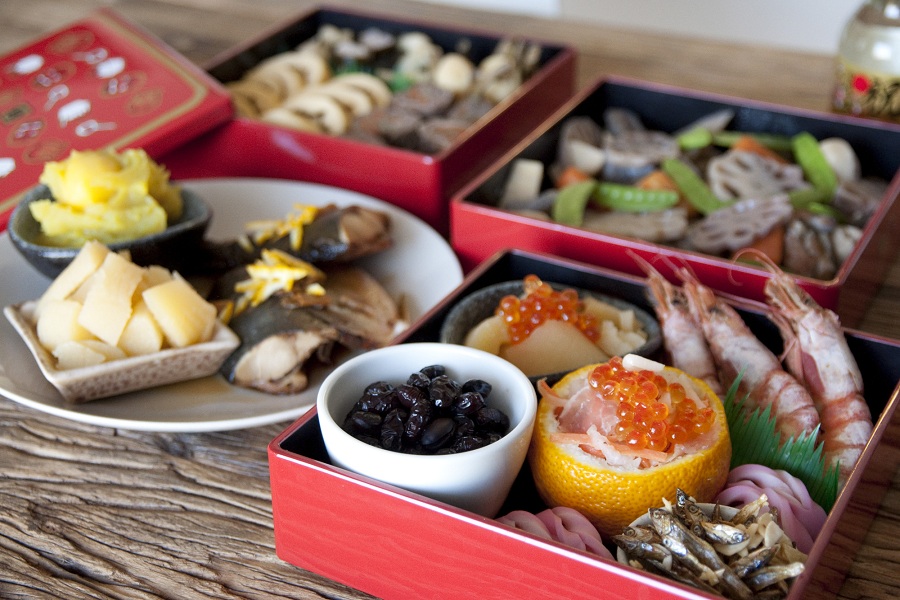
Osechi-ryori(お節料理)- I was training at Cirque Du Soleil headquarters in Montreal during New Years. It was so stupidly cold that the air hurt my face. I found a website where you could order things from Japan and have it shipped internationally. I bid on 8 different accounts to get the osechi-ryori shipped to me. Days later I received a saddening, “do not reply,” email, notifying me that because of importation laws, this type of food could not be shipped to my location. Internal tears ensued, and I spent the holiday eating Russian food, listening to Vladimir Putin and dancing to electronica with a bunch of acrobats.
Osechi-ryori is something only eaten during the beginning of the new year. Eaten at home, it’s not a dish you’ll find on any restaurant menu. This bento-style meal used to be how families survived during the first few days of the New Year, when all of the stores were closed. Osechi-ryori is meant to feed a few people for around 3 days. The food in osechi-ryori can all be made in advance, and can be stored without spoiling. – This has developed according to the tradition that nothing should be cooked on the first few days of the new year.
More recently, like most places around the world, people are too lazy to make their own osechi-ryori, as it takes a lot of time, culinary skill, and patience. You can easily order osechi-ryori from department stores or major grocery chains starting as early as late October, to be picked up before the new year. The meals start from just under ¥10,000 (around $100), and can go as high as $10,000 (yes,really), if made my famous chefs. My hard-core aunt makes osechi-ryori for her family every year.
In Japan so many things have meaning that it’s difficult to keep track of. Surprise, surprise, the different foods of osechi-ryori have meaning as well. Health, fortunate, and prosperity are among the common meanings (although not statistically proven). Japan loves to utilize in-season and local ingredients, so some of the dishes within osechi vary with region. Regardless, each dish acts as a wish or symbol for the new year.
Here are a few staple components of osechi-ryori and their meanings:
-
- Kuromame (black beans) 黒豆 - typically sweet, seasoned with soy sauce and sugar. Good health for the coming year
- Ebi (prawns) 海老 - boiled, presented with shell. Wish for long life
- Kamaboko (fish paste)蒲鉾 – often infused with intricate designs. Said to resemble the first sunrise of the New Year. The pink and white colors also serve as a talisman against evil (red), and for purity (white).
- Kombumaki (kombu – seaweed wrapped around a piece of gourd) 昆布巻き- umami-rich. Often rolled like a graduation scroll, this dish servers as a wish for scholarship and culture.
Another specialty of Japan, presentation is just as important as the food itself. There are many layers to osechi-ryori, and if you take a second to notice, you can see how efficiently the boxes are packed. Reflective of the Japanese’s uncanny ability to make the most of a tiny amount of space (see Tokyo capsule hotels and city life in general), it’s no wonder that this stack of boxes can efficiently and pleasurably feed an entire family for a number of days. The box itself is something to behold, lacquered with intricate designs.
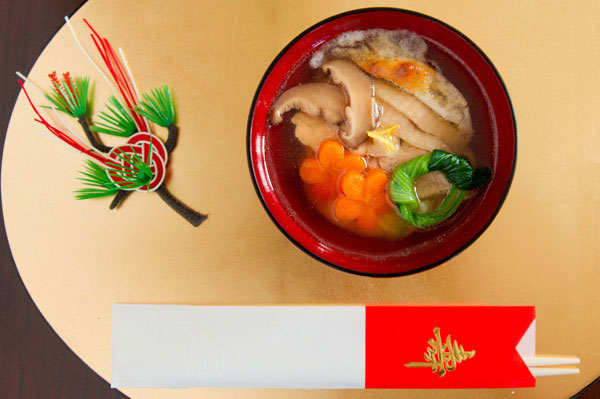
Ozoni (お雑煮)– This is a new year’s soup containing rice cakes and, depending on the region, other ingredients such as vegetables or meat. There are countless types of ozoni enjoyed around Japan ranging from the savory flavors of yellowtail and clams, to the ever-popular sweet red bean paste.
I can’t begin to count the number of times i’ve seen someone bite into a Japanese sweet, expecting chocolate or some other sugary treat, only to discover it was red bean. The horror.
The origins of ozoni are said to date back to the Muromachi era (a long time ago) from the family of the samurai, later spreading among the commoners. It was a side dish to accompany alcohol during banquets.
Another origin story of ozoni comes from the lush history of Japanese farmers. On New Year’s Day, the farmers would provide offerings to the gods such as rice, vegetables, and chicken. After the ceremony, the ingredients were thrown into a soup, resulting in ozoni.
Whatever the actual story may be, it’s a tasty dish eaten on the first day of the new year. A significant number of elderly people die annually because of ozoni, so take caution.
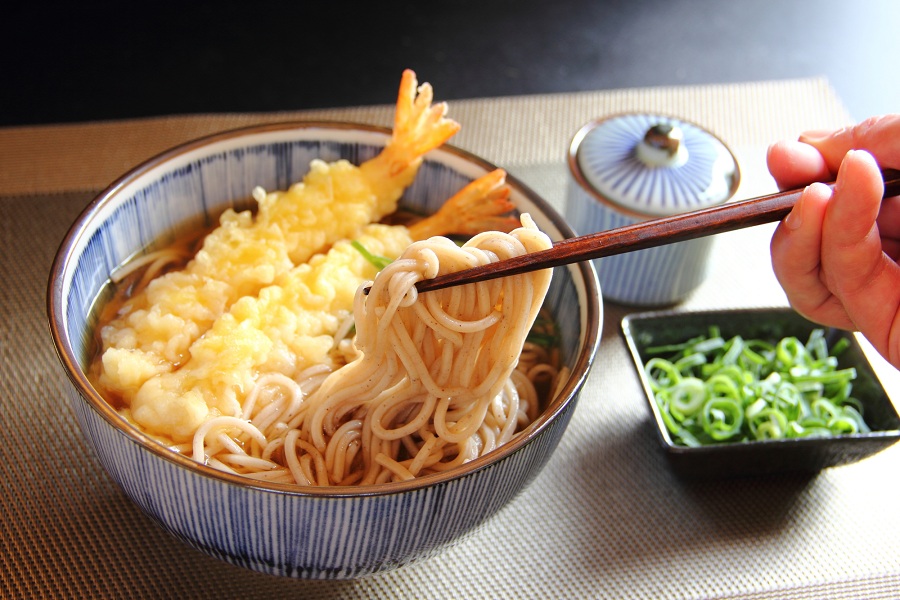
Toshikoshi soba (年越しそば)- A noodle has never had a more important job. The literal translation, ‘year-crossing soba,’ reflects this Japanese dish, often eaten as the last meal of the year. Soba is made from buckwheat flour, and the the toppings vary. The long noodles inspire a long life, but also, the thin soba noodles can easily be bitten off, signifying the clean ending (or cutting off) of the past year.
The soba noodles supposedly represent resiliency and strength, embodying the characteristics of the buckwheat plant.
Another origin story comes from goldsmiths, who once used fine soba flour to gather leftover gold dust. Soba became to gold as gold is to good fortune.
Here’s a dark one to end with; make sure to finish your food, as it’s considered bad luck if you don’t finish it all of your soba by the time midnight rolls around.

Medicinal Sake (屠蘇)- Toso, drunk on the morning of New Year’s Day, is a spiced, medicinal sake. It’s more of a ceremony rather than a drinking party, and is meant to wash away any poor fortune of the previous year, leaving room for good health and longevity.
The characters that make up the word toso represent ‘evil spirits’ and ‘defeat,’ respectively. Three small, shallow dishes of varying sizes are used to enjoy this traditional drink. Ingredients have changed, but it typically includes asiasari, cinnamon, ginger, rhubarb, and a smorgasbord of other chinese herbs and unpronounceable substances.
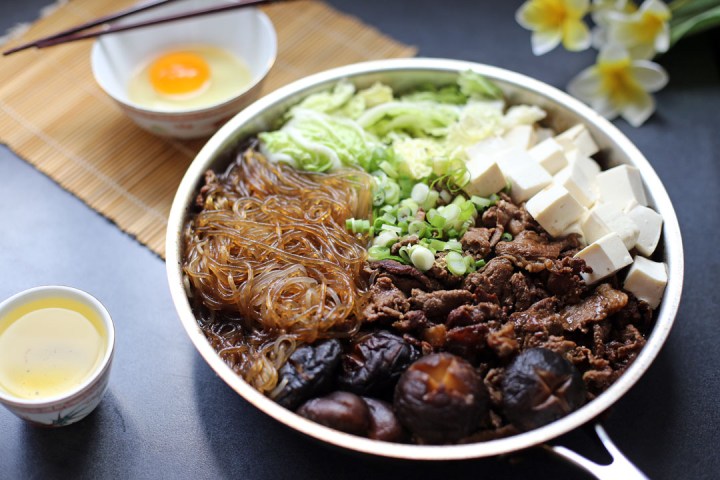
Other Foods: Other popular New Year’s foods include sushi and sashimi, seven-herb rice soup (nanakusa-gayu), and my personal favorite, sukiyaki. Sukiyaki is a hot-pot dish with meat and a variety of vegetables and other ingredients, simmered in a mixture of sugar, mirin, and soy sauce. Once cooked, the ingredients are enjoyed by dipping bites into a mixture of raw egg.
Actually, sukiyaki isn’t a traditional, nationally eaten New Year’s food in Japan. I’ve included it here because it’s the Isogawa family’s (my family’s) traditional New Year’s Eve dinner meal. We all sit around the kitchen table, sharing bites from the simmering pot, exchanging stories and laughs. By the end of the night, we sit with food babies on the couch, watching the year-end television specials, listening to my slightly drunk uncle playing music on his guitar.
ACTIVITIES
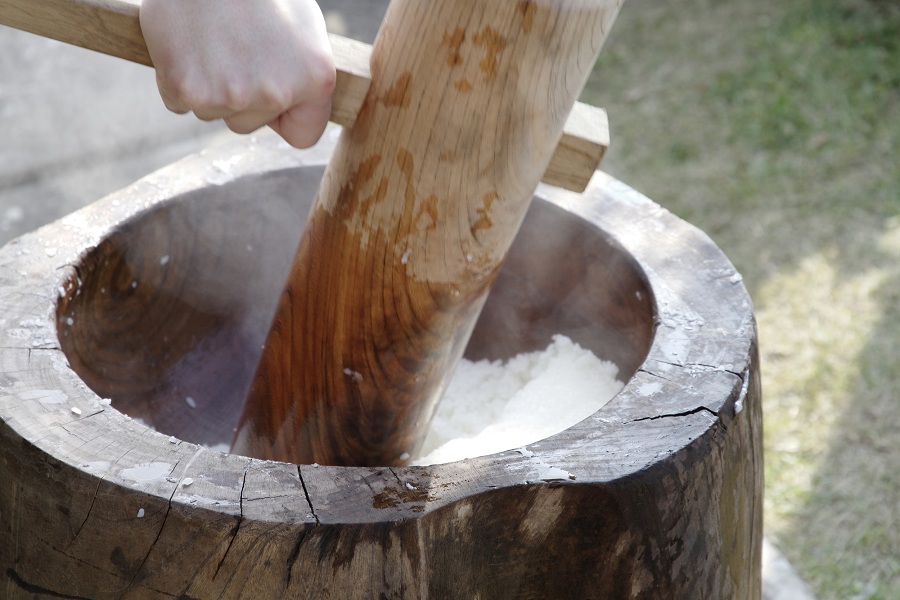
Making Mochi (餅つき)- mochitsuki is the process of making Japanese mochi by pounding cooked rice with a wooden mallet until desired. Time and labor intensive, this traditional activity is mainly only celebrated around the the new year.
Like everything else, the Japanese manage to take it to the next level with speed, precision, and enthusiasm. Not sure what I’m talking about? Check out this video.
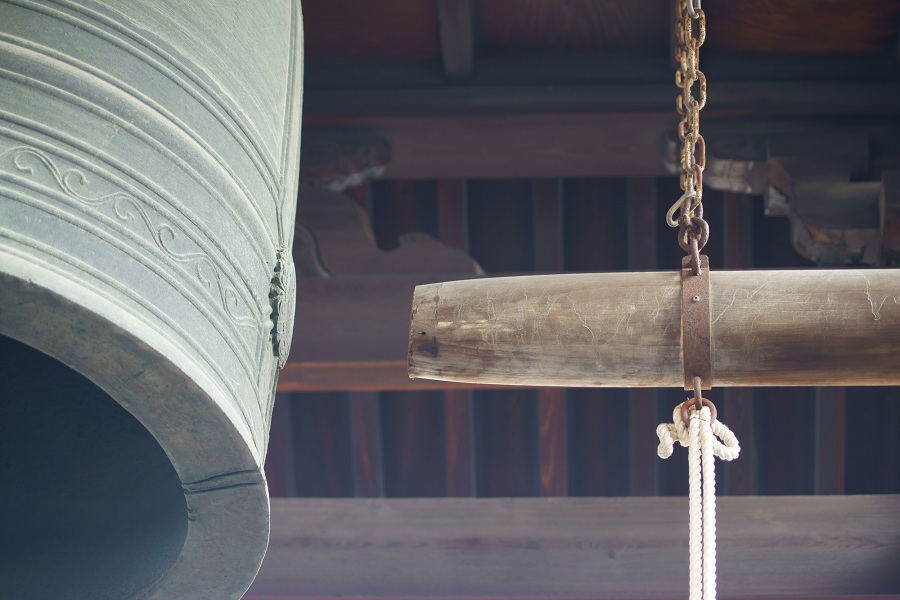
Bell Ringing (除夜の鐘)- On the night of New Year’s Eve, the bell rung at a temple is referred to as joya no kane. The bell is rung a total of 108 times, 107 times before midnight, and the final strike as it enters the new year. The number represents the 108 evils, or 108 worldly desires that a person has throughout their life. Originating from Buddhism, I won’t list all 108 desires (there’s only 108?) here, but you can read all about them here.
Imagine standing outside in Japan on New Year’s Eve, feeling the vibrations of all of the temples’ bells, being struck at the same time, all around the country. Between the deep reverberations and the winter night sky, it’s a powerful way to grab ahold of the year ahead.
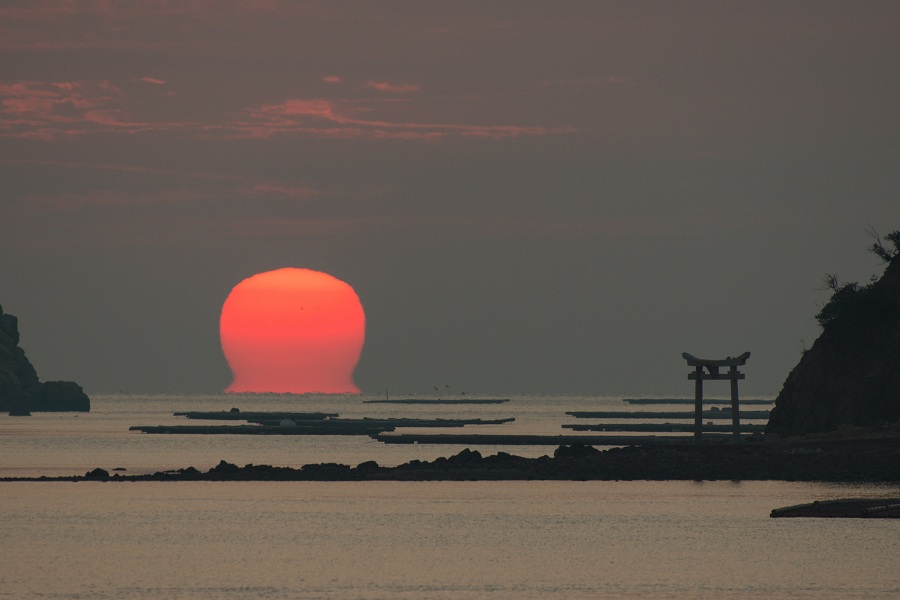
First Sunrise (初日の出) – Hatsuhinode is the first sunrise of the new year. Many Japanese believe that it has supernatural qualities, so praying at the first sight of the rising sun is said to bring good luck. The ultra-keen will head to the mountains or beach, to catch a truly magnificent view of the sunrise.
I might’ve done it a little backwards this year, watching New Year’s Eve’s sunrise instead. After scaling the side of an apartment building, climbing flights of stairs (hit my fitbit ‘floors-climbed’ goal before 6 am woo!), and chatting about the past and future as my hands shivered from the winter cold, the sun appeared. Gently spreading light across the sleepy city, the sight was breathtaking, and primitively magical. The thing is, this miracle isn’t reserved for one certain day of the year. It’s a daily occurrence. As long as our exploding ball of fire doesn’t one day implode and collapse into a infinitely massive black hole, we get to experience it every single day.
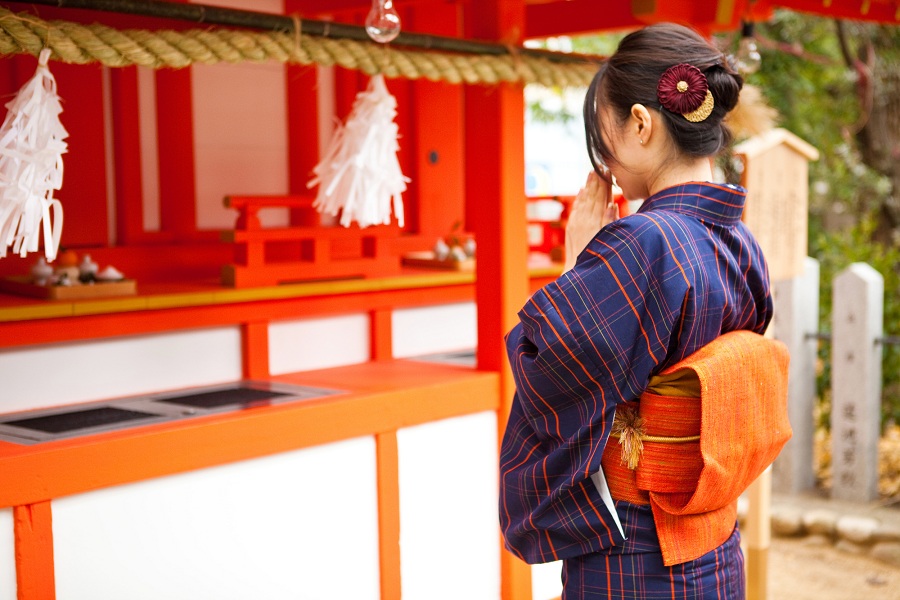
First Shrine Visit (初詣) – Hatsumoude is the first visit of the year to a Shinto shrine, usually within the first three days of the new year. Those who practice will line up with offerings, pull paper oracles (called omikuji), and purchase charms (omamori) after returning the old ones to be burned at the temple.
The famous Meiji shrine once had 3.45 million visitors over the course of 3 days.
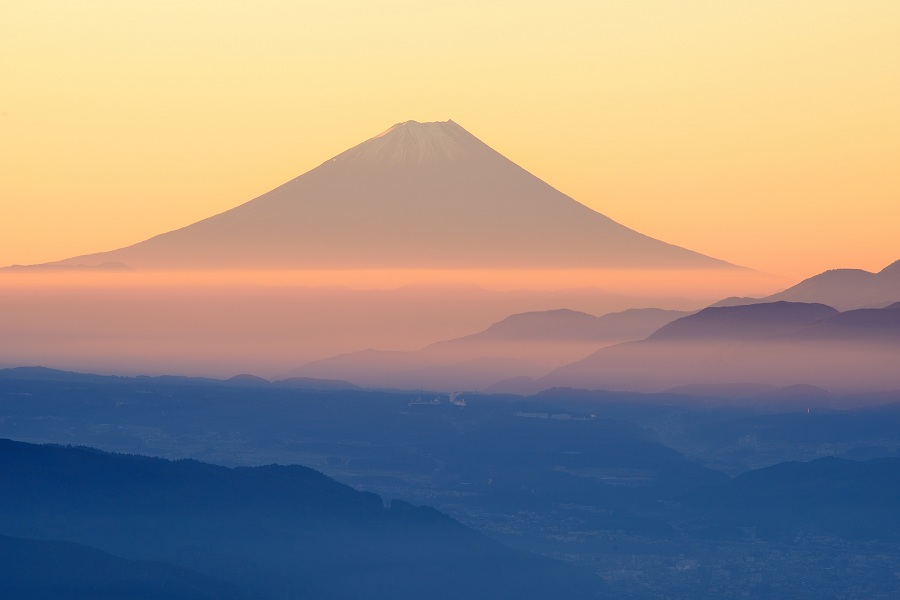
First Dream (初夢)- Many Japanese say that the first dream of the year (whether it is January 1st or January 2nd is unclear) fortells your luck for the rest of the year. Called hatsuyume, watch out for Mt. Fuji, a hawk, and an eggplant. If you spot those, specifically in that order, you’re supposedly the luckiest of them all! Japanese people are so into this, that back in the day, everyone would put a drawing of a treasure ship underneath their pillow.
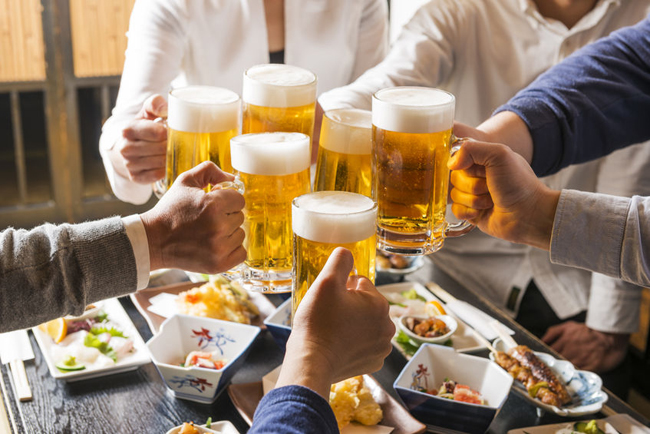
Forget The Year Party (忘年会)- The hard-working people of Japan have more than enough reasons to throw themselves a party. Bonenkai is an end-of-the-year-party that literally translates to, ‘forget the year.’ The purpose is to release the troubles of the past and look forward to the next. These are parties thrown among company members and friends, enjoyed together with co-workers and those who have shared your struggles throughout the year.
Full of speeches, games, and typically a lot of alcohol, you can expect these gatherings to get rowdy.
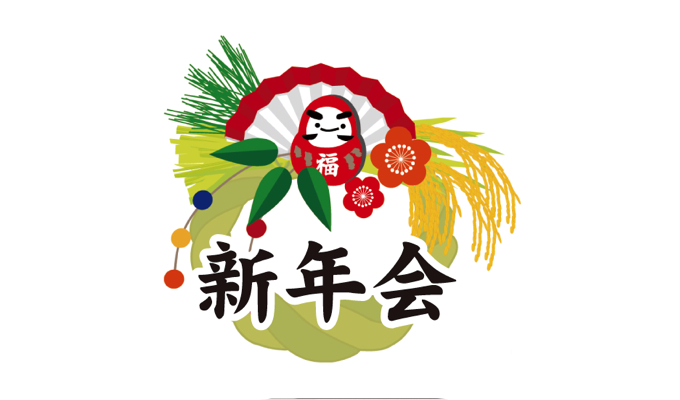
New Year’s Party (新年会)- Following the ‘forget the year party,’ many Japanese companies and groups throw a New Year’s party, or shinenkai. This party is more focused on welcoming and preparing for the new year. Promises are made, goals are set, and congratulations are exchanged at this party.
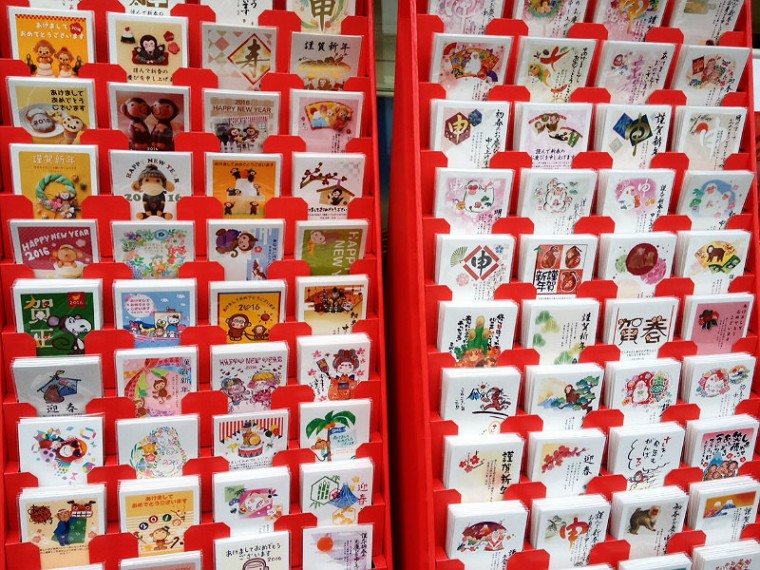
New Year’s Postcard (年賀状)- New Year’s greeting cards, the Japanese equivalent of American Christmas cards, are called Nengajyou. Send these to any person you want to show appreciation to for the past year. You can purchase beautiful New year’s postcards at most stationary stores, post offices, and supermarkets.
It’s popular that these postcards will have a design associated with the corresponding zodiac sign for the new year. Slip in a nice message, and send it off along with some good karma.
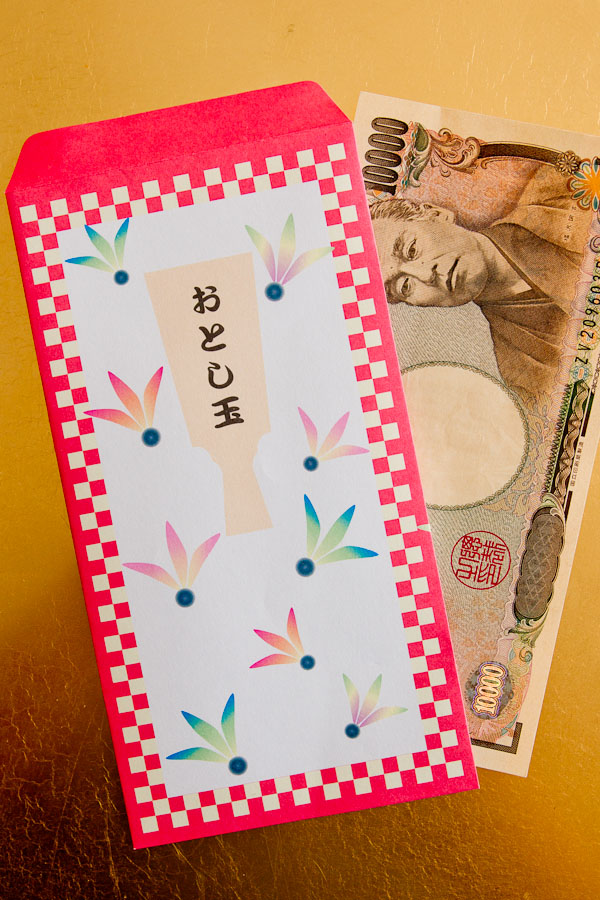
Envelopes Of Money (お年玉)- Don’t get too excited. These annual envelopes, called otoshidama, are gifted only to children. But, they are filled with cold hard cash. This tradition originated from rice cakes, called toshidama, given to children by their parents. The small rice cakes were replaced with small wooden or paper toys, and then developed to money.
These envelopes are given by parents, grandparents, aunts, uncles, and other close family members alike. It’s a surprisingly significant amount of cash, usually increasing with age, and can range from 2,000 to 10,000 yen ($20 – $100 or so) each.
What do Japanese kids spend all this money on? According to some random poll (really valid, right?) the top 3 items bought with this money are 1. Video games, 2. Mobile apps, and 3. Apparel.
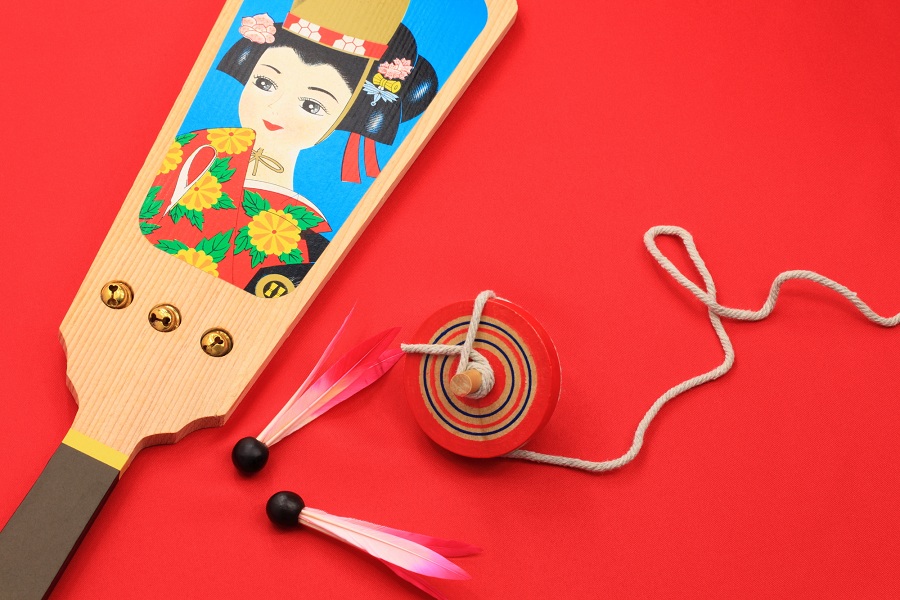
Hanetsuki (羽根突き)- a traditional Japanese game played with wooden paddles, similar to badmitton, but without a net. Apparently, the longer the brightly-colored shuttlecock remains in the air, the more the player will be protected from mosquitos during the new year. It’s also said that cherries were used in place of a shuttlecock during the creation of the game. Resourceful!
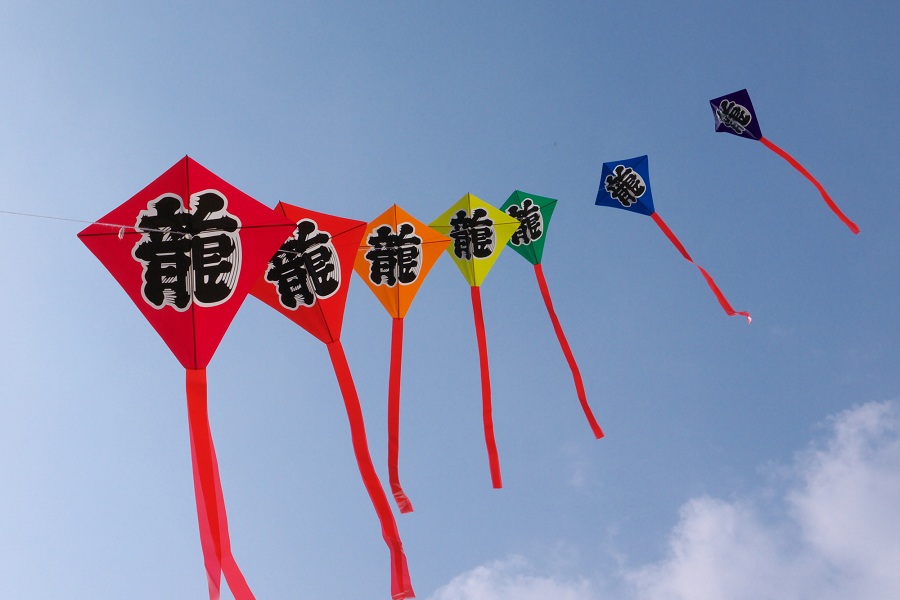
Kite Flying (凧上げ)- Takoage is the Japanese activity of kite flying, an activity often enjoyed around the new year. The kites come in all different shapes and sizes, designs, symbols, and prints.
Kite flying during the new year isn’t popular around the globe. The tradition comes from the late Edo Period, when people were only allowed to fly kites around New Year’s. The story goes: kites were really popular back then, so much so that people had kite battles that got so intense that the kites would fall onto traveling daimyo and aristocrats, making them angry. After that happened a few times, the government essentially put a ban on kite-flying except around the New Year.
I want to say that these aristocrats were overreacting, but i’d be pretty upset too if a kite came and hit me in the face.
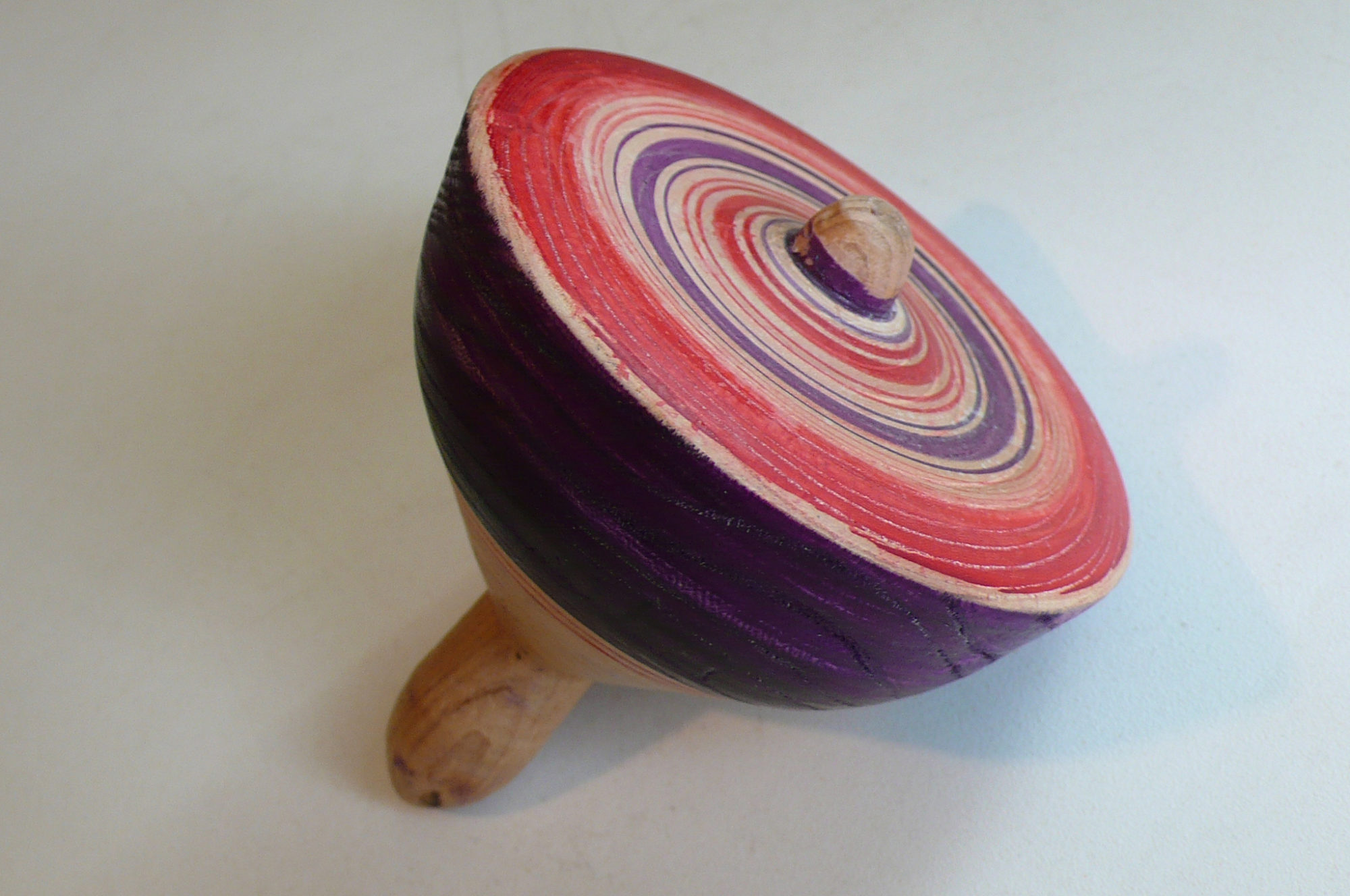
Spinning Tops (こま回し)- These wooden tops are spun and played with during an activity called koma-mawashi. The Spinning Top Museum in Nagoya (yes, a spinning top museum) says that the popularity of this toy came from what most great things do, marketing. The toy shops had plenty to sell during the warmer months, but nothing for the winter. Koma-mawashi was born.
The Japanese phrase, “standing on one leg,” has something to do with a person being a responsible adult (what?) and is reflected by the single leg that these tops spin on. Thus, the game carries a positive message, which toy shops took advantage of to sell during the new year season.
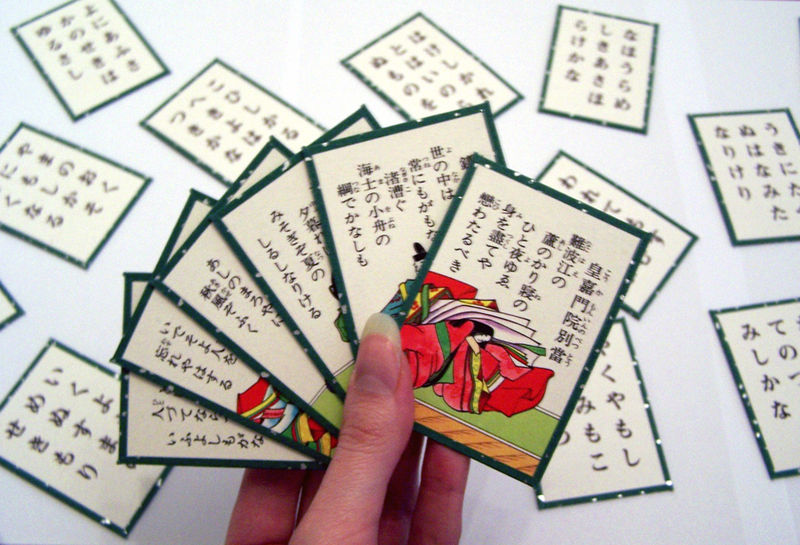
Cards (カルタ)- This isn’t your usual card game. In karuta, a poem is written on each card. The beginning of the poem is read, and players try to find and grab the card with the corresponding verses.
In the Japanese school I attended, we would be assigned weekly quizzes, in which we had to learn and memorize these various poems. We would practice all year, and once New Year’s rolled around, there was no holding back as we climbed over each other in search of that precious matching card. I still have scars.
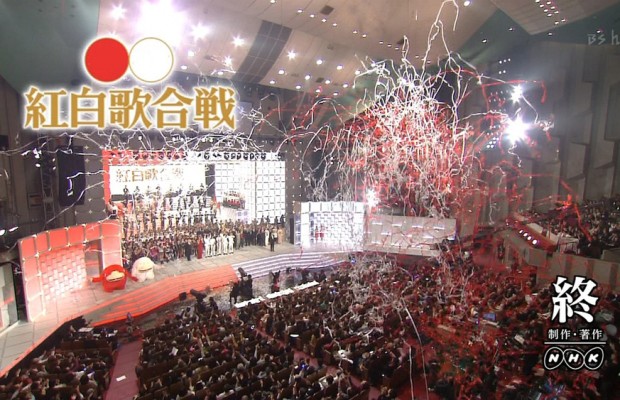
Television: Year End Song Festival (紅白歌合戦)- If I’m being completely honest, I’m writing this entire article while watching this Japanese TV special.
Kohaku Uta Gassen, called Kohaku for short, is an annual music show on New Year’s Eve. This television program takes the most popular Japanese musical artists of the year, splits them into two teams (red and white), and has them perform on a grand stage. At the end of the program, the audience and a panel of judges vote to decide the winner.
What does the winning team get? Nothing. Regardless, the artists strive to be on this television program because of the show’s wide reach as one of the most consistently-top-rated musical event of the year.
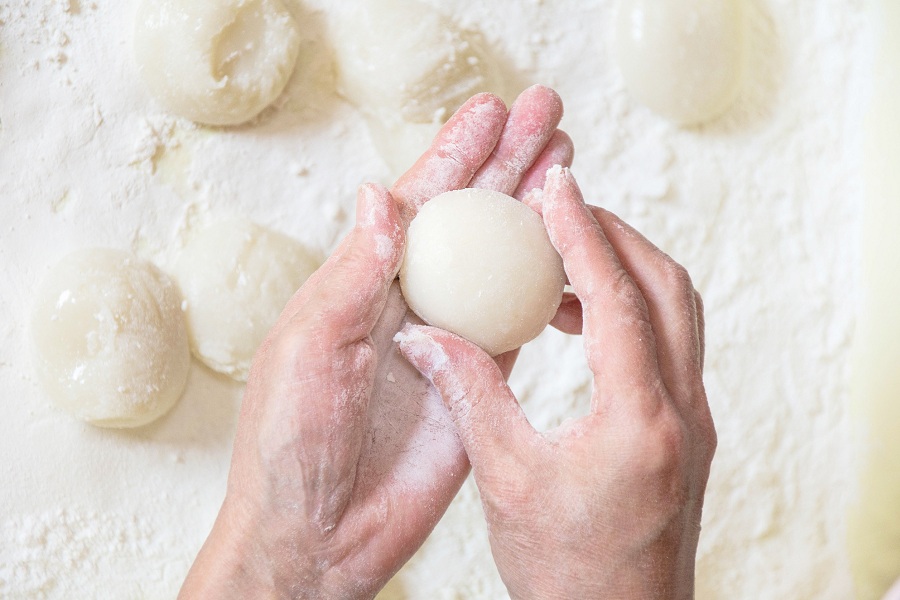
Other Games – Japan seems to have an extensive, and basically endless list of New Year’s activities. Some other games include fuku-warai, and sugoroku. Fuku-warai is like pin the tail on the donkey, but it’s played on a table, and you’re attempting to put together a human face. Sugoroku is a board game that is a mix of backgammon and snakes and ladders.
DECORATIONS
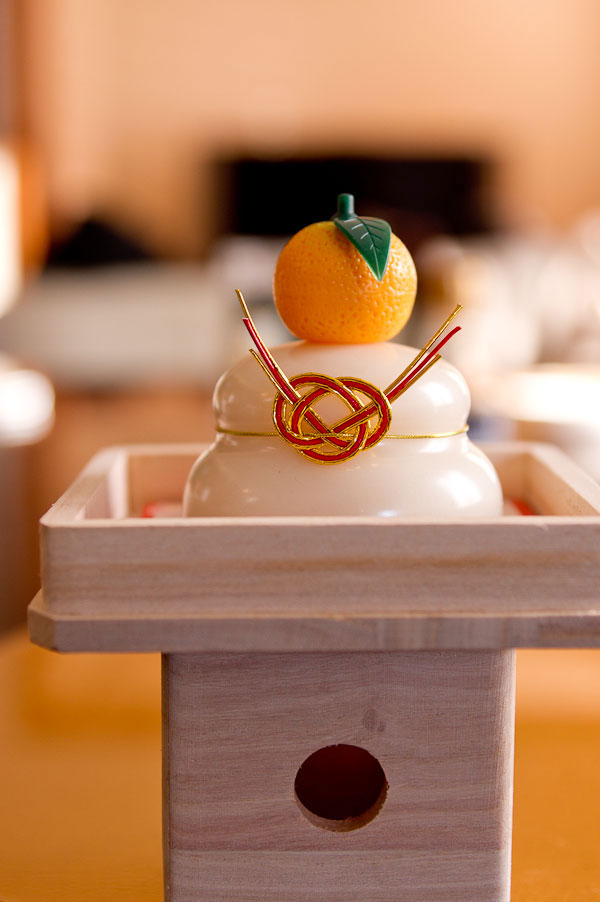
Japanese New Year Cake – there’s two components to this popular Japanese New Year’s decoration.
1 (Mandarin) みかん
A traditional Japanese New Year’s cake may be presented around the holiday. This cake consists of two round layers of mochi (rice cake), topped with an orange mandarin called mikan. Originally, the pounded rice cakes were topped with a different, bitter citrus fruit, called daidai, translated to, “generation after generation.” The mikan, being smaller and more palate-pleasing, is now used while still representing the concepts of longevity and health.
2 (Kagami-Mochi) 鏡餅
The round rice cakes have their own meaning. They are called kagami-mochi, or ‘mirror rice cake’ and have a story connected to the gods. In short, it is said that the sun god Amaterasu was drawn out of a cave by a mirror, bringing light back into the world. The significance of having specifically two discs is attributed to concepts such as: the coming-and-going years, the human heart, yin and yang, and the sun and moon. Ultimately, these mirror-shaped rice cakes symbolize the renewal of energy and light.
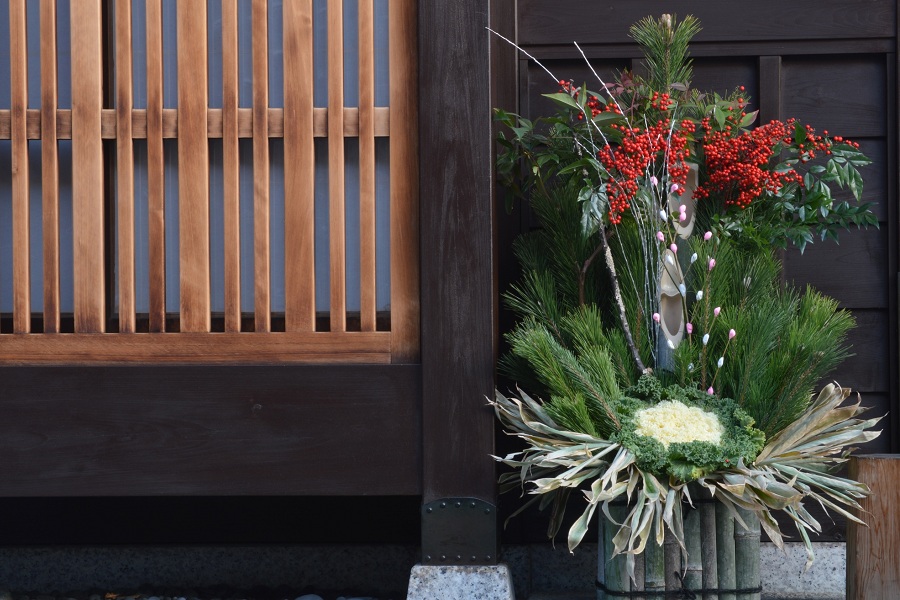
Kadomatsu (門松)- A decoration traditionally placed in front of homes to invite ancestral spirits, or gods of the harvest. Kadomatsu are usually made of pine, bamboo, and sprigs, to represent longevity, prosperity, and steadfastness, respectively.
The bamboo shoots are purposely placed at different heights to represent the levels of heaven, humanity, and earth. This decoration comes in pairs, typically being placed on either end of an entrance.
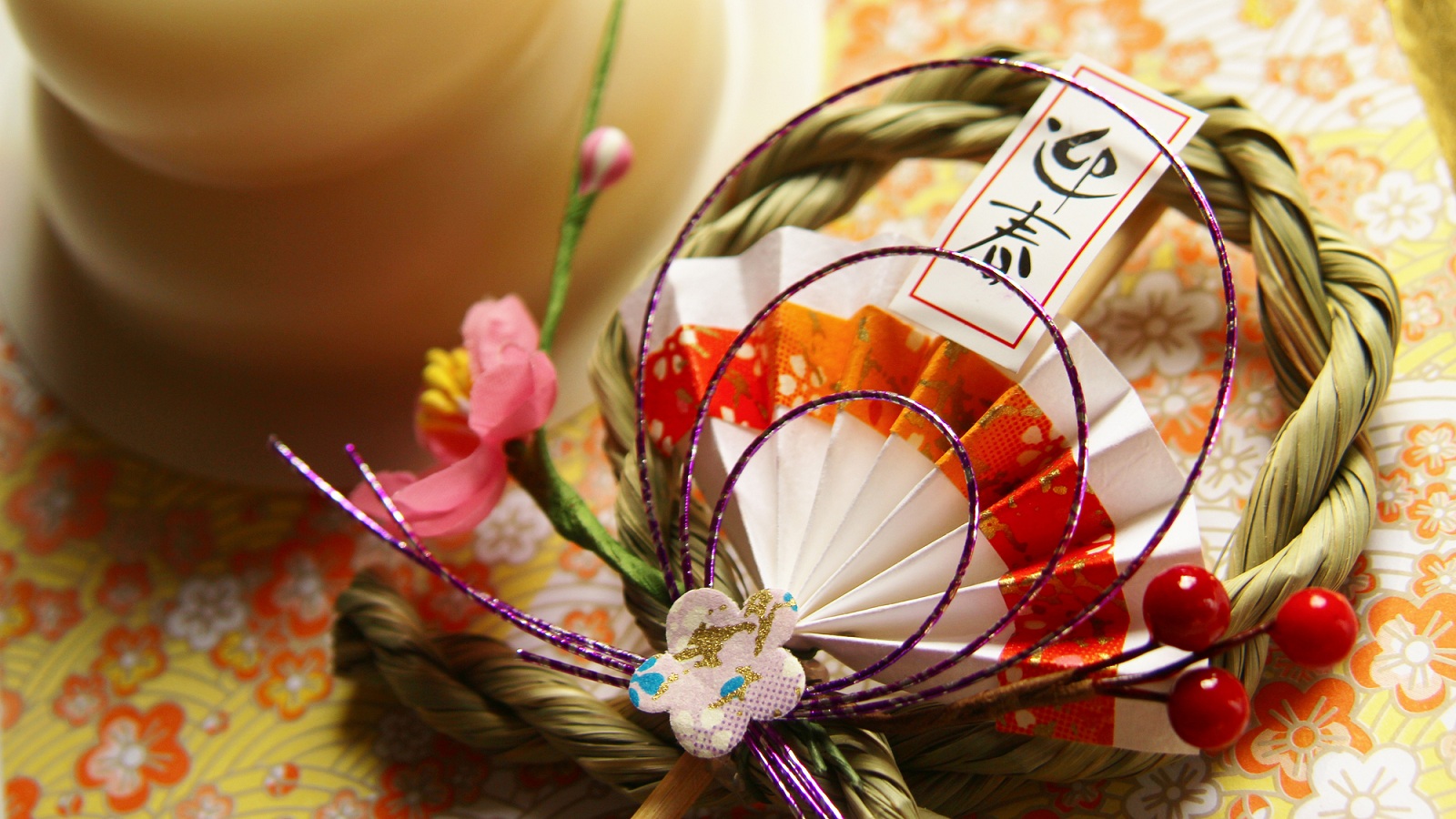
Shimenawa (しめ縄)- These decorations vary greatly in size and shape. Shimenawa are intricate weavings of rice straw rope, traditionally used for purification in the Shinto religion. Spaces associated with this decoration indicates a pure or sacred space. They are also said to ward against evil spirits.
We have a couple of shimenawa adorning various doorways around work. There’s an explanation posted with them, but it’s so cold out that I often see people start to read the description before stopping short to dive into the warmth inside.
…
No matter how you spend your New Year, I hope you are able to spend it together with loved ones, with warm hearts and full bellies.
Happy New Year
あけましておめでとうございます
(Akemashite Omedetou-Gozaimasu.)
…
Sources
https://en.wikipedia.org/wiki/Japanese_New_Year http://bento.com/fexp-osechi.html http://en.rocketnews24.com/2013/01/03/%E3%80%90japanese-culture%E3%80%91the-meaning-behind-osechi-ryori-traditional-new-years-food-in-japan/ http://en.rocketnews24.com/2013/12/30/the-meaning-of-the-mandarin-and-6-other-japanese-new-year-traditions-explained/ https://en.wikipedia.org/wiki/Amaterasu http://www.pbs.org/food/fresh-tastes/celebrate-japans-oshogatsu-with-ozoni/ http://jpninfo.com/40490 http://lajollamom.com/japanese-new-year-good-luck-food-osechi/ http://travel.rakuten.com/campaign/ranking/new-year/ http://web-japan.org/kidsweb/explore/calendar/december/mochitsuki.html http://www.japantimes.co.jp/life/2010/12/24/food/why-not-spend-new-years-eve-totally-soba/#.WGebl7Z961s https://matcha-jp.com/en/1340 https://en.wikipedia.org/wiki/Toso https://en.wikipedia.org/wiki/Hatsum%C5%8Dde http://bestlivingjapan.com/otoshidama/ https://en.wikipedia.org/wiki/Hanetsuki http://stayingglobal.blogspot.jp/2011/12/games-people-play-for-new-year.html http://www.japantimes.co.jp/culture/2015/01/01/general/looking-back-preserving-traditional-new-years-activities/#.WGeuerZ961s https://en.wikipedia.org/wiki/Fukuwarai https://en.wikipedia.org/wiki/Sugoroku http://web-japan.org/kidsweb/explore/calendar/january/hatsuyume.html https://en.wikipedia.org/wiki/Sukiyaki http://www.japan-talk.com/jt/new/bonenkai http://jpninfo.com/7630 https://blog.gaijinpot.com/nengajo-japanese-new-years-postcard/ https://en.wikipedia.org/wiki/K%C5%8Dhaku_Uta_Gassen https://en.wikipedia.org/wiki/Kadomatsu https://en.wikipedia.org/wiki/Shimenawa
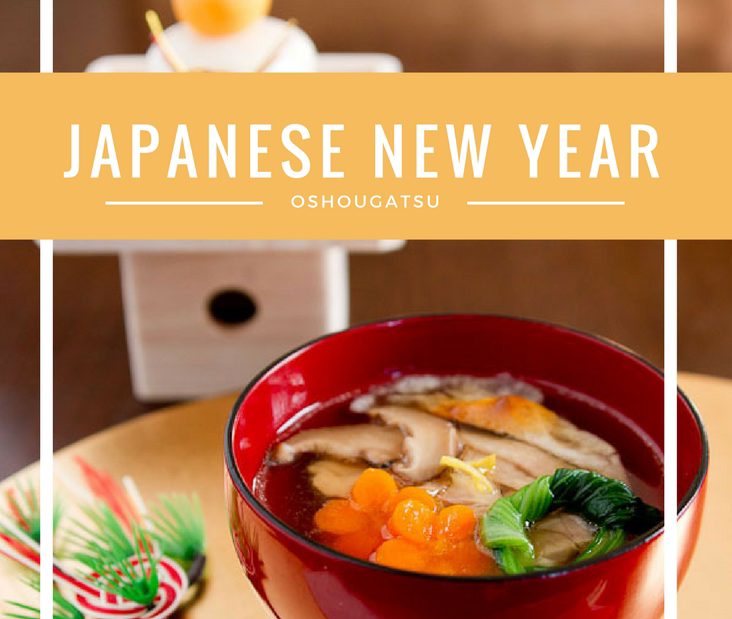
Loved this article, thank you!
Thank YOU! Happy new year 🙂